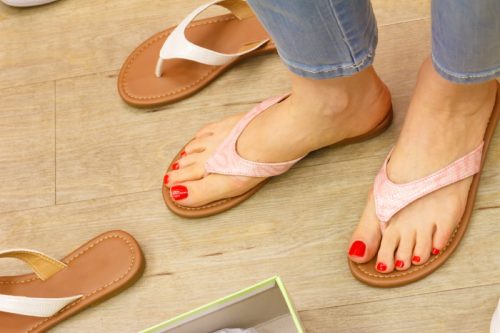If You're Over 65, Don't Wear These 5 Clothing Items When Traveling
Ensure that safety and style go hand in hand on your next trip.

You may be the type to travel in style, but if you're over 65, it's also time to start traveling in comfort and safety. Carefully choosing the right clothing items to wear on your trip is a great place to begin. In fact, health experts say there are five key things you should plan to leave at home if you're hoping to avoid injury, irritation, or unpleasant symptoms while setting off on your next adventure. Read on to learn which five clothing items you should never wear when traveling.
RELATED: If You're Over 65, Don't Wear These 6 Clothing Items to Exercise.
1
Unsafe footwear

Your choice of footwear can greatly impact your comfort and safety while traveling, especially if you're over 65, experts say.
Amanda Weeks MS, OTR/L, an occupational therapist with a concentration in older adults working with B. Well Health, says that in particular, you should plan to avoid flip-flops and backless footwear any time you take to the road.
"These types of shoes can contribute to an unstable gait, increasing the likelihood of trips and falls, which could be particularly dangerous for older adults with reduced balance and stability. Opting for more supportive footwear with better traction can help reduce the risk of falling or injury," she explains.
Similarly, high-heeled shoes can put you at risk while traveling, says Daniel Morris, founder of My Caring Plan. "Stability is critical for senior safety. They can have a sprain or turn an ankle due to high heels, shoes, or sandals. Flat shoes or shoes with a slight, wide heel are a safer choice. Opt for non-slip shoes or shoes with an excellent grip to reduce the risk of falls and slips," he tells Best Life.
RELATED: 7 Clothing Items to Never Wear Through Airport Security, Experts Say.
2
Shapewear

Another clothing item to avoid while traveling is shapewear, says Nancy Mitchell, RN, a registered nurse and a contributing writer at Assisted Living. In particular, she warns against garments made of Lycra and Spandex.
"Wearing them for extended periods can reduce the flow of blood and fluids throughout your lower body. If you
suffer from diabetes and other circulatory issues, this could put you at risk for edema (severe swelling)," she says.
Mitchell adds that wearing Spandex or similar materials can also increase your risk of yeast infections and rashes.
"Older adults have highly sensitive skin and are more prone to skin irritations. Traveling may demand a lot of walking and activities which produce heat. When that heat festers in moist areas, like the groin and skin folds, this increases your likelihood of developing microbial infections or aggravating issues you may already have," she explains.
RELATED: 6 Things You Should Never Eat or Drink on a Plane If You're Over 60.
3
Uncomfortable or ill-fitting masks

While mask mandates have died down since the start of the pandemic, it's still wise to wear one in a crowd. For instance, you may still wish to wear a mask in transit on a plane, train, bus, or in crowded stores once you've reached your destination.
But Jennifer Silver, DDS, a dentist practicing with Macleod Trail Dental, says you should never wear an ill-fitting mask when you travel.
"Uncomfortable masks can cause breathing difficulties, while ill-fitting ones may lead to skin irritation and reduced effectiveness. Opt for breathable materials and adjustable ear loops for a snug fit. Avoid constant adjustments that increase contamination risks," she says.
RELATED: The 10 Best U.S. Cities to Visit if You're Over 60.
4
Ill-fitting or hard-to-manage clothes

Morris says that ill-fitting clothes are best avoided while traveling. Too-tight clothing can lead to discomfort, restricted movement, and poor circulation, while loose and baggy clothes can pose a tripping hazard.
"It's better to wear well-fitting clothes that allow free movement without the risk of tripping. Comfortable, breathable clothing that is not too tight or too loose is the way to go," he says.
Weeks adds that you should also skip any clothing item that's hard to put on or take off. "Older adults should avoid wearing difficult-to-manage clothing while traveling, as it's often difficult locating a bathroom quickly in a new place. Complicated outfits with multiple layers, clasps, or small buttons can be time-consuming to remove, causing unnecessary stress in urgent situations," she tells Best Life.
For more travel tips sent directly to your inbox, sign up for our daily newsletter.
5
Heavy jewelry and dangling accessories

Weeks also advises leaving your heavy jewelry at home when you travel—especially if you're over 65.
"Not only can it be lost or stolen during travel, but it can also cause discomfort over time. For example, older people can experience neck pain from a heavy necklace during a day-long tour," she says.
Similarly, dangling accessories can pose an accident risk if your scarf or necklace becomes entangled while on your neck. For optimal travel safety, stick to minimal jewelry and accessories.





















